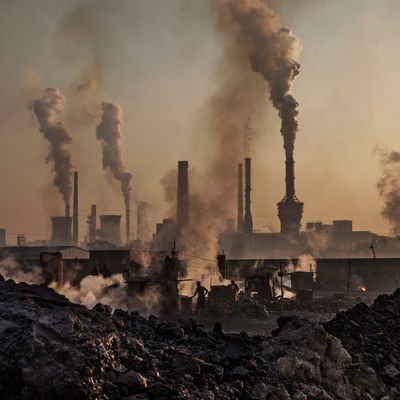
For the past three years, humanity has managed to keep global carbon emissions virtually stable. In 2014, emissions increased by a mere 0.7 percent, down from an average annual rate of 2.3 percent in the preceding decade. The following year saw zero emissions growth, while 2016 saw a piddling 0.2 percent rise.
This development was among the most hopeful signs that climate scientists had seen in a generation. Emissions plateaued, even as the global economy grew. A better world looked possible.
But there was a catch: Even as emissions held steady, the amount of carbon in the atmosphere continued to grow at a historic rate. In 2015 and 2016, the amount of excess carbon dioxide trapping heat above the Earth rose at the highest rate in recorded history. A marginally slower — but still historically high — rate of increase has continued into 2017, according to readings from a climate-monitoring station in (the aptly named) Cape Grim, Tasmania.
The 2017 finding is critical: Many scientists had attributed the contradiction between slowing emissions and rising atmospheric carbon to El Niño. But El Niño ended early last year, and the rise has continued, forcing scientists to entertain far more alarming explanations. The New York Times’ Justin Gillis details one leading theory:
Scientists have spent decades measuring what was happening to all of the carbon dioxide that was produced when people burned coal, oil and natural gas. They established that less than half of the gas was remaining in the atmosphere and warming the planet. The rest was being absorbed by the ocean and the land surface, in roughly equal amounts.
In essence, these natural sponges were doing humanity a huge service by disposing of much of its gaseous waste. But as emissions have risen higher and higher, it has been unclear how much longer the natural sponges will be able to keep up.
Should they weaken, the result would be something akin to garbage workers going on strike, but on a grand scale: The amount of carbon dioxide in the atmosphere would rise faster, speeding global warming even beyond its present rate. It is already fast enough to destabilize the weather, cause the seas to rise and threaten the polar ice sheets.
The record increases of airborne carbon dioxide in 2015 and 2016 thus raise the question of whether this has now come to pass.
The scientists who spoke with Gillis emphasized that this conclusion remains highly speculative. But the theory’s growing plausibility offers yet another reminder that uncertainty about climate projections cuts both ways — reality could prove less catastrophic than the consensus of climate models suggests, but it could also prove much, much more so.
Happily, humanity is comporting itself with ever-increasing rationality in the face of this growing threat. Just kidding! The most powerful country in the world made a climate-change skeptic its president, and coal burning is on the upswing in China, India, and the United States. After a record global decline in coal usage last year, production crept up 6 percent through the first five months of 2017, according to the Associated Press.
The rise was driven by a temporary spike in natural gas prices in the U.S., an economic recovery in China, and India’s ongoing efforts to bring electricity to its poor.
Coal’s long-term prospects remain grim; the uptick is expected to be fleeting. But then, so is our window for averting catastrophic climate change.






























